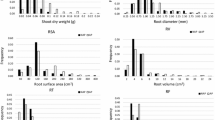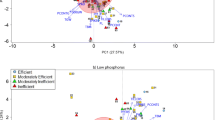Abstract
Genetic improvement of crops is an essential approach to overcome the aluminum (Al) toxicity in acidic soils. The objectives of this study were to identify contrasting popcorn inbred lines with respect to Al tolerance and investigate its genetic control. Using a complete randomized block design, three sequential experiments were performed that assessed 18, 10, and 2 inbred lines growing in the presence and absence of Al. The inbreds were assessed for relative root growth (RRG), hematoxylin staining, Al content, and external root morphology. Then, the two most contrasting inbreds were crossed and jointly assessed with four derived generations in a fourth trial in a complete randomized block design. The plants were assessed for relative and net root length. The inbred 11–60 had the least RRG (0.02 and 0.06), the greatest accumulation of Al (1660.3 μg/g), and strong blue staining of the root tips with intense epidermal degradation. The inbred 11–133 had the most RRG (0.15–0.37) and the least hematoxylin staining, Al accumulation (926.4 μg/g), and root inhibition in the root tips, associated with no damages on root apices. Dominance effect contributed negatively with all Al-tolerance indexes, although in general, the average degree of dominance indicated partial dominance. The dominance × dominance effects contributed to increasing relative root length, whereas additive × additive effects increased net lateral root length. The individual narrow-sense heritabilities were high, ranging from 49.0 to 66.0%. Based in the results, recurrent selection based on progeny and hybrid breeding are recommended for developing Al-tolerant populations.




Similar content being viewed by others
References
Almeida VC, Viana JMS, Risso LA, Ribeiro C, DeLima RO (2018) Generation means analysis for nitrogen and phosphorus uptake, utilization, and translocation indexes at vegetative stage in tropical popcorn. Euphytica 214:103
Azizi F, Rezai AM, Saeidi G (2006) Generation mean analysis to estimate genetic parameters for different traits in two crosses of corn inbred lines at three planting densities. J Agric Sci Technol 8:153–169
Boni TA, Prioli AJ, Prioli SMAP, Lucio LC, DeMello R (2009) Inheritance of aluminum tolerance in maize. Crop Breed Appl Biot 9:147–153
Bouma TJ, Nielsen KL, Koutstaal B (2000) Sample preparation and scanning protocol for computerised analysis of root length and diameter. Plant Soil 218:185–196
Cançado GMA, Loguercio LL, Martins PR, Parentoni SN, Paiva E, Borém A, Lopes MA (1999) Hematoxylin staining as a phenotypic index for aluminum tolerance selection in tropical maize (Zea mays L.). Theor Appl Genet 99:747–754
Castilhos G, Farias JG, Schneider AB, de Oliveira PH, Nicoloso FT, Schetinger MRC, Delatorre CA (2011) Aluminum-stress response in oat genotypes with monogenic tolerance. Environ Exp Bot 74:114–121
Čiamporová M (2002) Morphological and structural response of plant roots to aluminum at organ, tissue and cellular levels. Biol Plantarum 45:161–171
Clark RT, Famoso AN, Zhao K, Shaff JE, Craft EJ (2013) High-throughput two-dimensional root system phenotyping platform facilitates genetic analysis of root growth and development. Plant Cell Environ 36:454–466
Coelho CJ, Molin D, DeJong G, Gardingo JR, Caires EF, Matiello RR (2016) Brazilian maize landraces: source of aluminum tolerance. Aust J Crop Sci 10:42–49
Conceição LDHCS, Tessele C, Neto JFB (2009) Diallel analysis and mapping of aluminum tolerance in corn inbred lines. Maydica 54:55–61
Delhaize E, Craig S, Beaton CD, Beet RJ, Jagads VC, Randall PJ (1993) Aluminum tolerance in wheat uptake and distribution of aluminum in root apices. Plant Physiol 03:685–693
Ertiro BT, Beyene Y, Das B, Mugo S, Olsen M, Oikeh S, Juma C, Labuschagne M, Prasanna BM (2017) Combining ability and testcross performance of drought-tolerant maize inbred lines under stress and non-stress environments in Kenya. Plant Breed 136:197–205
Eticha D, Thé C, Welcker C, Narro L, Staß A, Horst WJ (2005) Aluminium-induced callose formation in root apices: inheritance and selection trait for adaptation of tropical maize to acid soils. Field Crop Res 93:252–263
Famoso AN, Clark RT, Shaff JE, Craft E, Susan R (2010) Development of a novel aluminum tolerance phenotyping platform used for comparisons of cereal aluminum tolerance and investigations into rice aluminum tolerance mechanisms. Plant Physiol 153:1678–1691
Farias EST, Pintro JC, Silva MAG, Muniz AS, Marchetti ME, Nolla A, Pellisson N (2011) Aluminum toxicity in corn plants cultivated with low and high ionic strength nutrient solutions. J Plant Nutr 34:465–475
Giannakoula A, Moustakas M, Mylona P, Papadakis L, Yupsani T (2008) Aluminum tolerance in maize is correlated with increased levels of minerals nutrients, carbohydrates and proline, and decreased levels of lipids peroxidation and accumulation. J Plant Physiol 165:385–396
Górny AJ, Banaszak Z, Ługowska B, Ratajczak D (2011) Inheritance of the efficiency of nitrogen uptake and utilization in winter wheat (Triticum aestivum L.) under diverse nutrition levels. Euphytica 177:191–206
Guevara P, Poschenrieder C, Barceló J (1992) Differential response of four maize (Zea mays L.) varieties to aluminum toxicity. Suelo Y Planta 2:713–721
Horst WJ, Wang YX, Eticha D (2010) The role of the root apoplast in aluminum-induced inhibition of root elongation and in aluminum tolerance of plants: a review. Ann Bot 106:185–197
Kearsey MJ, Pooni HS (1996) The genetic analysis of quantitative traits, 1st edn. Chapman and Hall, London
Kere GM, Guo Q, Shen J, Xu J, Chen J (2013) Heritability and gene effects for salinity tolerance in cucumber (Cucumis sativus L.) estimated by generation mean analysis. Sci Hortic 159:122–127
Kochian L, Piñeros M, Liu J, Magalhaes J (2015) Plant adaptation to acid soils: the molecular basis for crop aluminum resistance. Annu Rev of Plant Biol 23:1–23
Kopittke PM, Blamey FPC, Menzies NW (2008) Toxicities of soluble Al, Cu and La include ruptures to rhizodermal and root cortical cells of cowpea. Plant Soil 303:217–227
Kosareva IA (2012) The study of crops and wild relatives collections for characteristic of resistance to toxic elements of acid soils. Proc Appl Bot Gen Breed 170:35–45
Lyimo HJF, Pratt RC, Mnyuku RSOW (2011) Heritability and gene effect estimates for components of partial resistance to grey leaf spot of maize by generation mean analysis. Plant Breed 130:633–639
Ma JF, Shen R, Nagao S, Tanimoto E (2004) Aluminum targets elongating cells by reducing cell wall extensibility in wheat roots. Plant Cell Physiol 35:583–589
Magnavaca R, Gardner CO, Clark RB (1987) Inheritance of aluminum tolerance in maize. In: Gabelman HW, Loughman BC (eds) Genetic aspects of plant mineral nutrition. Martinus Nijhoff Publishers, Dordrecht, pp 201–212
Maron L, Pineros MA, Guimaraes CT, Magalhaes JV, Pleiman JK, Mao C, Shaff J, Belicuas SNJ, Kochian LV (2010) Two functionally distinct members of the MATE (multi-drug and toxic compound extrusion) family of transporters potentially underlie two major aluminum tolerance QTLs in maize. Plant J 61:728–740
Mather K, Jinks JL (1971) Biometrical genetics. Cornell University Press, Ithaca
Matonyei TK, Cheprot RK, Liu J (2014) Physiological and molecular analysis of aluminum tolerance in selected Kenyan maize lines. Plant Soil 377:357–367
Moroni JS, Briggs KG, Blenis PV, Taylor GJ (2013) Generation mean analysis of spring wheat (Triticum aestivum L.) seedlings tolerant to high levels of manganese. Euphytica 189:89–100
Motoda H, Kano Y, Hiragami F, Kawamura K, Matsumoto H (2010) Morphological changes in the apex of pea roots during and after recovery from aluminum treatment. Plant Soil 333:49–58
Mutimaamba C, MacRobert J, Cairns JE, Magorokosho CE, Ndhlela T, Mukungurutse C, Minnaar-Ontong A, Labuschagne MT (2017) Diallel analysis of acid soil tolerant and susceptible maize inbred lines for grain yield under acid and non-acid soil conditions. Euphytica 213:88
Ninamango-Cárdenas FL, Guimarães CT, Martins PR, Parentoni SN, Carneiro NP, Lopes MA, Moro JR, Paiva E (2003) Mapping QTLs for aluminum tolerance in maize. Euphytica 130:223–232
Pérez Velásquez JC, DeSouza CL, Narro LA, Pandey S, de León CL (2008) Genetic effects for maize traits in acid and nonacid soils. Genet Mol Biol 97:89–97
Piñeros MA, Magalhaes JV, Alves VMC, Kochian LV (2002) The physiology and biophysics of an aluminum tolerance mechanism based on root citrate exudation in maize. Plant Physiol 129:1194–1206
Piñeros MA, Shaff JE, Manslank HS, Alves VM (2005) Aluminum resistance in maize cannot be solely explained by root organic acid exudation. A comparative physiological study. Plant Physiol 137:231–241
Polle EKCF, Kittrick JA (1978) Visual detection of aluminum tolerance levels in wheat by hematoxylin staining of seedling roots. Crop Sci 18:823–827
Poschenrieder C, Gunsé B, Corrales I, Barceló J (2008) A glance into aluminum toxicity and resistance in plants. Sci Total Environ 400:356–368
Revilla P, Malvar RA, Cartea ME, Butrón A, Ordás A (2000) Inheritance of cold tolerance at emergence and during early season growth in maize. Crop Sci 40:1579–1585
SAS Institute (2007) The SAS system for Windows, version 9.2. SAS Institute Inc, Cary
Setotaw TA, Nunes CF, Souza CS, Ribeiro AP, Freitas GF, Amorim DA, Santos DN, Pasqual M, Ferreira JL, Cançado GMA (2015) Assessment of tolerance to Aluminum toxicity in olive (‘Olea europaea’) based on root growth and organic acid Al3+ exclusion mechanism. Aust J Crop Sci 9:264–270
Souza LT, Cambraia J, Ribeiro C, Oliveira JA, Silva LC (2016) Effects of aluminum on the elongation and external morphology of root tips in two maize genotypes. Bragantia 75:19–25
Trachsel S, Messmer R, Stamp P, Hund A (2009) Mapping of QTLs for lateral and axile root growth of tropical maize. Theor Appl Genet 119:1413–1424
Uzokwe VNE, Asafo-Adjei B, Fawole I, Abaidoo R, Odeh IOA, Ojo DK, Dashiell K, Sanginga N (2017) Generation mean analysis of phosphorus-use efficiency in freely nodulating soybean crosses grown in low-phosphorus soil. Plant Breed 136:139–146
Verma A, Singh Y (2018) Generation mean analysis of horticultural traits in mid-late cauliflower (Brassica oleracea L. var. botrytis) under sub temperate conditions of Western Himalayas. Plant Breed 137:97–108
Worku M, Bänziger M, Schulte auf’m Erley G, Friesen D, Diallo AO, Horst WJ (2012) Nitrogen efficiency as related to dry matter partitioning and root system size in tropical mid-altitude maize hybrids under different levels of nitrogen stress. Field Crop Res 130:57–67
Yang JL, Li YY, Zhang YJ, Zhang SS, Wu YR, Wu P, Zheng SJ (2008) Cell wall polysaccharides are specifically involved in the exclusion of aluminum from the rice root apex. Plant Physiol 146:602–661
Zhang L, Li J, Rong T, Gao S, Wu F, Xu J, Li M, Cao M, Wang J, Hu E, Liu Y, Lu Y (2014) Large-scale screening maize germplasm for low-phosphorus tolerance using multiple selection criteria. Euphytica 197:435–446
Acknowledgements
We thank the National Council for Scientific and Technological Development (CNPq), the Brazilian Federal Agency for Support and Evaluation of Graduate Education (Capes), the Foundation for Research Support of Minas Gerais State (Fapemig), and The World Academy of Sciences (TWAS) for financial support.
Author information
Authors and Affiliations
Corresponding author
Ethics declarations
Conflict of interest
The authors declare that they have no conflict of interest.
Additional information
Publisher's Note
Springer Nature remains neutral with regard to jurisdictional claims in published maps and institutional affiliations.
Rights and permissions
About this article
Cite this article
Rahim, F., Almeida, V.C., Viana, J.M.S. et al. Identification of contrasting tropical popcorn inbreds for studying aluminum toxicity tolerance inheritance. Euphytica 215, 47 (2019). https://doi.org/10.1007/s10681-019-2372-y
Received:
Accepted:
Published:
DOI: https://doi.org/10.1007/s10681-019-2372-y




